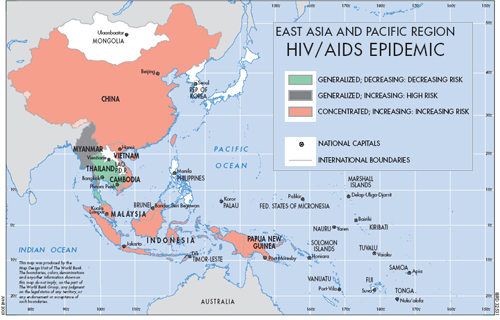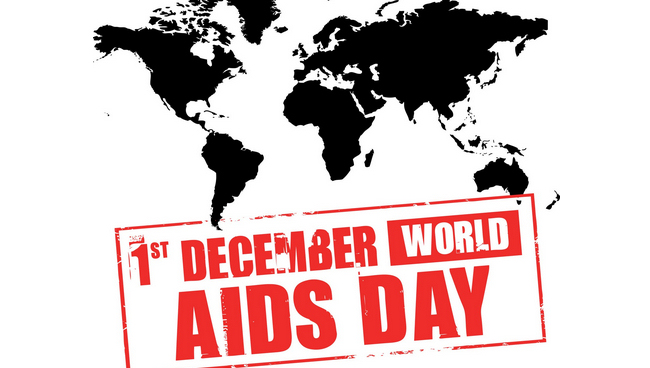Today is World AIDS Day, a day to raise awareness about the global fight to end new HIV infections and to seek more effective treatments for AIDS. Earlier this year, I wrote a post listing 10 Facts You Probably Didn’t Know about HIV/AIDS in the AAPI Community for May 19th’s AAPI HIV/AIDS Awareness Day.
This post will list 10 facts you probably didn’t know about HIV/AIDS in Asia.

1. Roughly 5 million people are currently living with HIV in East, South and Southeast Asia, and in the Pacific Islands. According to the United Nation, nearly 5 million people are currently living with HIV in Asia, and an additional 53,000 people are currently living with HIV in the Pacific Islands . While prevalence rates are low relative to other parts of the world, the large population size of many Asian countries mean that even a low prevalence still translates into a large patient population. For example, in India, roughly 0.1% of the adult population is HIV-positive; yet, this still translates into 2.3 million people.
2. Asia ranks second in the world for the largest AIDS-related death toll, after sub-Saharan Africa. According to the World Health Organization, roughly 1.9 million people die of AIDS-related complications every year; approximately 250,000 of those patients are from Asia.
3. In general, the rate of new HIV infections in Asia is decreasing. These falling rates are due to concerted efforts at increasing HIV/AIDS awareness particularly in certain Asian countries such as Thailand and Cambodia, and to improve antiretroviral therapy access.
4. By contrast, the rate of new HIV infections has increased by 25% in some Southeast Asian countries. Whereas in many parts of Asia, the rate of new HIV infections is decreasing, the rate of new HIV infections has increased by 25% between 2001 and 2011 in Bangladesh, Sri Lanka, Indonesia and the Phillipines.
5. In Central Asia, the rate of new HIV infections has increased by 1100%. The World Health Organization further notes intravenous drug use as the primary mode of transmission in this region.
6. Asia has low rates of antiretroviral therapy coverage of any part of the world. The World Health Organization reports that in 2010 approximately 39% of patients in East, South, and Southeast Asia receive retroviral therapies, compared to 49% of patients in sub-Saharan Africa and 63% of patients in Latin America. The United Nations estimated that in East Asia, antiretroviral therapy coverage is particularly low, at only 18% of eligible patients. Only North Africa and low-income parts of Europe and Central Asia ranked lower in antiretroviral therapy coverage than Asia as a whole. Thankfully, antiretroviral therapy coverage rates are rising throughout the world, including in low- and middle-income countries.
7. In Asia, the three populations most vulnerable to new HIV infections are intravenous drug users, sex workers, and men who have unprotected sex with other men. The relative prevalence of HIV in each of these vulnerable populations varies by Asian country. For example, in Indonesia, 35% of intravenous drug users are HIV-positive, whereas only 2% of intravenous drug users are HIV-positive in Bangladesh. This likely reflects the differing HIV public health policies in these varying Asian nations.
8. Transgender populations throughout Asia are particularly vulnerable, particularly because limited data are available for this community. In Indonesia, for example, an estimated 21.9% of the transgender population is HIV-positive. These high HIV rates are compounded by low HIV awareness; in Indonesia, only 32% of the transgender population had comprehensive HIV knowledge.
9. Pregnant Asian women have low HIV testing rates. Transmission between mothers and fetuses are another significant source of transmission, yet the World Health Organization estimates that in 2010, only 30% of pregnant mothers in East, South or Southeast Asia receive HIV tests, compared to sub-Saharan Africa (42%), Latin America (61%) and Eastern Europe and Central Asia (59%). Only in North Africa, and in parts of Western Africa (where testing rates is virtually nonexistent), were HIV testing rates among pregnant women lower than in Asia. Consequently, only about 16% of pregnant women in East, South or Southeast Asia are receiving effective therapies to prevent mother-to-child HIV transmission, the second lowest coverage rate in the world.
10. Until 2010, China restricted travel for the world’s HIV-positive population. Only in 2010 did China lift its controversial travel restrictions banning entry of any HIV-positive traveller. Similar travel restrictions were also lifted in Fiji and in South Korea, however Aids Map reports that at the time of China’s reversal of its ban, approximately 51 countries worldwide still imposed some sort of restrictions on movement of HIV-positive people.
Act Now! While significant progress has been made throughout the world in fighting the HIV/AIDS epidemic, more work must be done including in parts of Asia and the Pacific Islands.
Therefore, for World AIDS Day, please take a minute to share this post and help spread awareness about the global fight against HIV/AIDS. If you can spare it, you can also donate some funds to non-profits that are working at the forefront of this battle, such as the Foundation for AIDS Research (amfAR) or AVERT.
If you are aware of Asia-specific organizations that could also use support, please feel free to add them in the comments section below!


